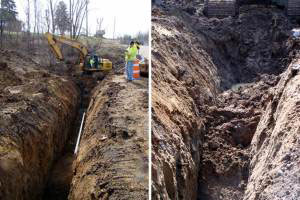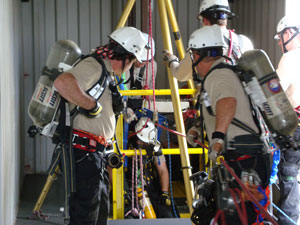 A month after a 33-year-old worker died while working in an unprotected trench, OSHA inspectors found another employee of the same Missouri plumbing contractor working in a similarly unprotected trench at another job site. OSHA determined that, in both cases, the company failed to provide basic safeguards to prevent trench collapse and did not train its employees to recognize and avoid cave-in and other hazards. OSHA issued 14 safety violations found during both inspections, and proposed penalties totaling $714,142.
A month after a 33-year-old worker died while working in an unprotected trench, OSHA inspectors found another employee of the same Missouri plumbing contractor working in a similarly unprotected trench at another job site. OSHA determined that, in both cases, the company failed to provide basic safeguards to prevent trench collapse and did not train its employees to recognize and avoid cave-in and other hazards. OSHA issued 14 safety violations found during both inspections, and proposed penalties totaling $714,142.
Trench collapses are among the most dangerous hazards in the construction industry.
Twenty-three deaths from trench and excavation operations were reported in 2016. In the first five months of 2017, at least 15 fatalities have been reported nationwide.
Gain knowledge, develop skills, and learn to recognize trench hazards by registering for Roco's Trench Rescue course. Our desire is for everyone to return home safely each day, and for this fatality number to not continue to increase.
Source: OSHA QuickTakes July 2017


 On 6/30/17, at approximately 4:23 AM, the East Side Fire Department (ESFD) was contacted by the Denham Springs Fire Department (DSFD) to provide technical rescue assistance on the Amite River Bridge just outside the City of Baton Rouge. DSFD requested high angle rescue personnel to aid the fire personnel already on the scene in rescuing a person who had jumped from the Hwy. 190 bridge span. While in route to the incident, East Side personnel were advised that the person who jumped had fallen approximately 40 ft. and had succumb to his injuries. High angle rescue support was still needed to transport the deceased up to the roadway surface.
On 6/30/17, at approximately 4:23 AM, the East Side Fire Department (ESFD) was contacted by the Denham Springs Fire Department (DSFD) to provide technical rescue assistance on the Amite River Bridge just outside the City of Baton Rouge. DSFD requested high angle rescue personnel to aid the fire personnel already on the scene in rescuing a person who had jumped from the Hwy. 190 bridge span. While in route to the incident, East Side personnel were advised that the person who jumped had fallen approximately 40 ft. and had succumb to his injuries. High angle rescue support was still needed to transport the deceased up to the roadway surface.
 Roco would like to commend both the Denham Springs Fire Department and the East Side Fire Department for a safe and efficient recovery.
Roco would like to commend both the Denham Springs Fire Department and the East Side Fire Department for a safe and efficient recovery. The Rescucender is one more quality piece of rescue hardware for your toolbox. Roco is proud to have been one of the first rescue training companies approached by Petzl to be shown the new device and asked to evaluate it. We were excited to see and use it from Day 1, and we then added it to our training kits as soon as they became available.
The Rescucender is one more quality piece of rescue hardware for your toolbox. Roco is proud to have been one of the first rescue training companies approached by Petzl to be shown the new device and asked to evaluate it. We were excited to see and use it from Day 1, and we then added it to our training kits as soon as they became available. As with any piece of rescue equipment, it is important to be properly trained in its use. The action for opening and closing the Rescucender becomes very intuitive in a short amount of time. The engagement and movement of the shoe along its guides oozes precision and the solid feel in your hand lends a high degree of confidence. The device is equipped with a spring that has a light action and is primarily intended to prevent fouling. Our experience is the cam runs rather freely down the rope in vertical applications when attached to a pulley. This provides the convenience of creating longer “throws” with a Z-rig or piggy-back hauling system. The balance between the spring action and the need for the cam to remain open in progress capture applications is spot on. It also has just enough passive camming action to remain in place without back-sliding during rope ascents. It runs free when you need it to, and then grabs the rope when needed.
As with any piece of rescue equipment, it is important to be properly trained in its use. The action for opening and closing the Rescucender becomes very intuitive in a short amount of time. The engagement and movement of the shoe along its guides oozes precision and the solid feel in your hand lends a high degree of confidence. The device is equipped with a spring that has a light action and is primarily intended to prevent fouling. Our experience is the cam runs rather freely down the rope in vertical applications when attached to a pulley. This provides the convenience of creating longer “throws” with a Z-rig or piggy-back hauling system. The balance between the spring action and the need for the cam to remain open in progress capture applications is spot on. It also has just enough passive camming action to remain in place without back-sliding during rope ascents. It runs free when you need it to, and then grabs the rope when needed. I continue to be excited about the evolution of rescue equipment. It doesn’t seem that long ago that we moved from goldline ropes to kernmantle, but years would go by without seeing any major breakthroughs in modern equipment. Well, those days are over. It seems that the digital era, as well as the push from various agencies and users, combined with the “out-of-the-box” thinking of equipment designers is driving the rapid emergence of better and better rescue mousetraps.
I continue to be excited about the evolution of rescue equipment. It doesn’t seem that long ago that we moved from goldline ropes to kernmantle, but years would go by without seeing any major breakthroughs in modern equipment. Well, those days are over. It seems that the digital era, as well as the push from various agencies and users, combined with the “out-of-the-box” thinking of equipment designers is driving the rapid emergence of better and better rescue mousetraps. House passes bill to toughen penalties for harming first responders
House passes bill to toughen penalties for harming first responders We recently had a request for additional information beyond what was shown in our “
We recently had a request for additional information beyond what was shown in our “






